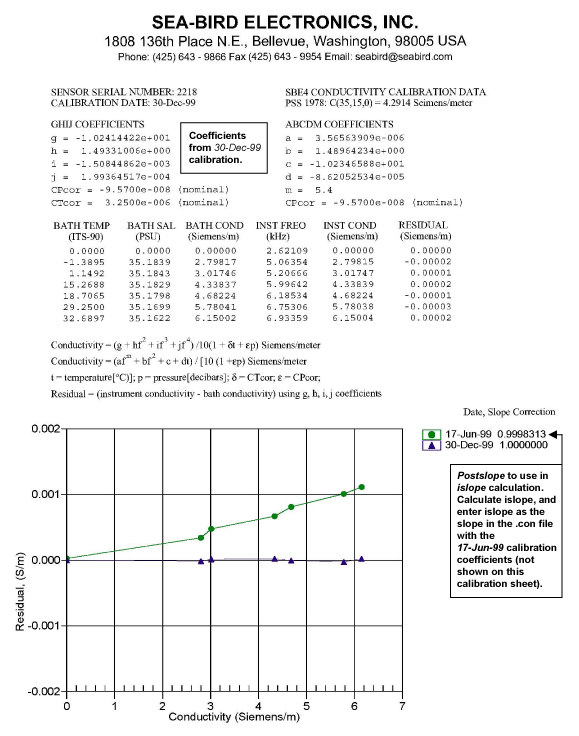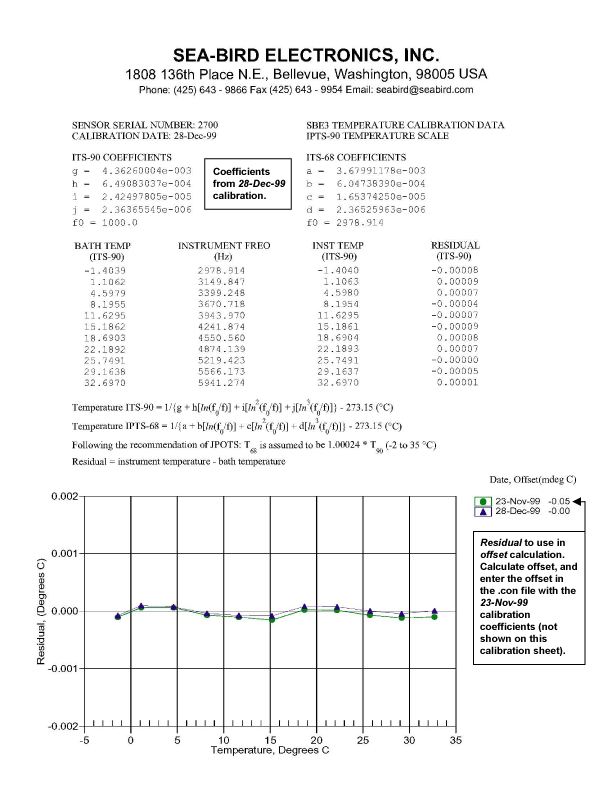APPLICATION NOTE NO. 31
Computing Temperature and
Conductivity Slope and Offset Correction Coefficients
from Laboratory Calibrations and
Salinity Bottle Samples
Revised February 2010
![]()
The conductivity sensor slope and offset values in the configuration (.con or .xmlcon) file in SEASOFT permit the user to make corrections for sensor drift between calibrations. The correction formula is:
(corrected conductivity) = slope * (computed conductivity) + offset
where
slope = (true conductivity span) / (instrument reading conductivity span)
offset = (true conductivity - instrument reading conductivity) * slope measured at 0 S/m
For newly calibrated sensors use slope = 1.0, offset = 0.0.
Sea-Bird conductivity sensors usually drift by changing span (the slope of the calibration curve), and changes are typically toward lower conductivity readings with time. Any offset error in conductivity (error at 0 S/m) is usually due to electronics drift, typically less than ±0.0001 S/m per year. Offsets greater than ±0.0002 S/m are symptomatic of sensor malfunction. Therefore, Sea-Bird recommends that conductivity drift corrections be made by assuming no offset error, unless there is strong evidence to the contrary or a special need.
Example
true conductivity = 3.5 S/m
instrument reading conductivity = 3.49965 S/m
slope = 3.5 / 3.49965 = 1.000100
Correcting for Conductivity Drift Based on Pre- and Post-Cruise Laboratory Calibrations
Suppose a conductivity sensor is calibrated (pre-cruise), then immediately used at-sea, and then returned for post-cruise calibration. The pre- and post-cruise calibration data can be used to generate a slope correction for data obtained between the pre- and post-cruise calibrations.
If a is the conductivity computed from the pre-cruise bath data (temperature and frequency) using post-cruise calibration coefficients and b is the true conductivity in the pre-cruise bath, then:

Sea-Bird calculates and prints the value for postslope on the conductivity calibration sheet for all calibrations since February 1995 (see Appendix I: Example Conductivity Calibration Sheet).
To correct conductivity data taken between pre- and post-cruise calibrations:
islope = 1.0 + (b/n)( (1/postslope) - 1.0)
where
islope = interpolated slope; this is the value to enter in the configuration (.con or .xmlcon) file
b = number of days between pre-cruise calibration and the cast to be corrected
n = number of days between pre- and post-cruise calibrations
postslope = slope from calibration sheet as calculated above (see Appendix I: Example Conductivity Calibration Sheet)
In the configuration (.con or .xmlcon) file, use the pre-cruise calibration coefficients and use islope for the value of slope.*
NOTE: In our SEASOFT V2 suite of programs, edit the CTD configuration (.con or .xmlcon) file using the Configure Inputs menu in Seasave V7 (real-time data acquisition software) or the Configure menu in SBE Data Processing (data processing software).
For typical conductivity drift rates (equivalent to -0.003 PSU/month), islope does not need to be recalculated more frequently than at weekly intervals.
* You can also calculate preslope. If a is the conductivity computed from the post-cruise bath data (temperature and frequency) using pre-cruise calibration coefficients and b is the true conductivity in the post-cruise bath, then:
In this case, pre-cruise calibration coefficients would be used and islope = 1.0 + (b/n)(preslope - 1.0) .
Correcting for Conductivity Drift Based on Salinity Bottles Taken At Sea
For this situation, the pre-cruise calibration coefficients are used to compute conductivity and CTD salinity. Salinity samples are obtained using water sampler bottles during CTD profiles, and the difference between CTD salinity and bottle salinity is used to determine the drift in conductivity.
In using this method to correct conductivity, it is important to realize that differences between CTD salinity and hydrographic bottle salinity are due to errors in conductivity, temperature, and pressure measurements (as well as errors in obtaining and analyzing bottle salinity values). For typical Sea-Bird sensors that are calibrated regularly, 70 - 90% of the CTD salinity error is due to conductivity calibration drift, 10 - 30% is due to temperature calibration drift, and 0 - 10% is due to pressure calibration drift. All CTD temperature and pressure errors and bottle errors must first be corrected before attributing the remaining salinity difference as CTD conductivity error and proceeding with conductivity corrections.
Example
Three salinity bottles are taken during a CTD profile; assume for this discussion that shipboard analysis of the bottle salinities is perfect. The uncorrected CTD data (from Seasave) and bottle salinities are:
Approximate
Depth
(m)CTD Raw Pressure
(dbar)CTD Raw Temperature
(°C) *CTD Raw Conductivity
(S/m)CTD Raw Salinity Bottle Salinity 200 202.7 18.3880 4.63421 34.9705 34.9770 1000 1008.8 3.9831 3.25349 34.4634 34.4710 4000 4064.1 1.4524 3.16777 34.6778 34.6850 *Temperatures shown are ITS-90. However, the salinity equation is in terms of IPTS-68; you must convert ITS-90 to IPTS-68 (IPTS-68 = 1.00024 * ITS-90) before calculating salinity. SEASOFT does this automatically.
The uncorrected salinity differences (CTD raw salinity - bottle salinity) are approximately -0.007 psu. To determine conductivity drift, first correct the CTD temperature and pressure data. Suppose that the error in temperature is +0.0015 °C uniformly at all temperatures, and the error in pressure is +0.5 dbar uniformly at all pressures (drift offsets are obtained by projecting the drift history of both sensors from pre-cruise calibrations). Enter these offsets in the configuration (.con or .xmlcon) file to calculate the corrected CTD temperature and pressure, and calculate the CTD salinity using the corrected CTD temperature and pressure. This correction method assumes that the pressure coefficient for the conductivity cell is correct. The CTD data with corrected temperature and pressure are:
Corrected CTD
Pressure (dbar)Corrected CTD
Temperature (°C)CTD Raw Conductivity
(S/m)CTD Salinity
[T,P corrected]Bottle Salinity 202.2 18.3865 4.63421 34.9719 34.9770 1008.3 3.9816 3.25349 34.4653 34.4710 4063.6 1.4509 3.16777 34.6795 34.6850 The (CTD-bottle) salinity difference of -0.005 psu is now properly categorized as conductivity error, equivalent to about -0.0005 S/m at 4.0 S/m.
Compute bottle conductivity (conductivity calculated from bottle salinity and CTD temperature and pressure) using SeacalcW (in SBE Data Processing); enter bottle salinity for salinity, corrected CTD temperature for ITS-90 temperature, and corrected CTD pressure for pressure:
CTD Raw Conductivity (S/m) Bottle Conductivity (S/m) [CTD - Bottle] Conductivity (S/m) 4.63421 4.63481 -0.00060 3.25349 3.25398 -0.00049 3.16777 3.16822 -0.00044 By plotting conductivity error versus conductivity, it is evident that the drift is primarily a slope change. If a is the CTD conductivity computed with pre-cruise coefficients and b is the true bottle conductivity, then:
Using the above data, the slope correction coefficient for conductivity at this station is:
Slope = [(4.63421 * 4.63481) + (3.25349 * 3.25398) + (3.16777 * 3.16822)] /
[(4.63421 * 4.63421) + (3.25349 * 3.25349) + (3.16777 * 3.16777)] = +1.000138Following Sea-Bird's recommendation of assuming no offset error in conductivity, set offset to 0.0.
The temperature sensor slope and offset entries in the configuration (.con or .xmlcon) file in SEASOFT permit the user to make corrections for sensor drift between calibrations. The correction formula is:
(corrected temperature) = slope * (computed temperature) + offset
where :
slope = (true temperature span) / (instrument reading temperature span)
offset = (true temperature - instrument reading temperature) * slope measured at 0.0 °C
For newly calibrated sensors, use slope = 1.0, offset = 0.0.
Sea-Bird temperature sensors usually drift by changing offset (an error of equal magnitude at all temperatures). In general, the drift can be toward higher or lower temperature with time; however, for a specific sensor the drift remains the same sign (direction) for many consecutive years.
Many years of experience with thousands of sensors indicates that the drift is smooth and uniform with time, allowing users to make very accurate corrections to field data based only on pre- and post-cruise laboratory calibrations.Span errors cause slope errors, as described in the equation for slope above. Sea-Bird temperature sensors rarely exhibit span errors larger than 0.005 °C over the range -5 to 35 °C, even after years of drift. Temperature calibrations preformed at Sea-Bird since January 1995 have slope errors less than 0.0002 °C in 30 °C. Prior to January 1993, some calibrations were delivered that include slope errors up to 0.004 °C in 30 °C because of undetected systematic errors in calibration. A slope error that increases more than ±0.0002 [°C per °C per year] indicates an unusual aging of electronic components and is symptomatic of sensor malfunction. Therefore, Sea-Bird recommends that drift corrections to temperature sensors be made by assuming no slope error, unless there is strong evidence to the contrary or a special need.
Calibration checks at-sea are advisable for consistency checks of the sensor drift rate and for early detection of sensor malfunction. However, data from reversing thermometers is rarely accurate enough to make calibration corrections that are better than those possible by shore-based laboratory calibrations. For the SBE 9plus, a proven alternate consistency check is to use dual SBE 3 temperature sensors on the CTD and to track the difference in drift rates between the two sensors. In the deep ocean, where temperatures are uniform, the difference in temperature measured by two sensors can be resolved to better then 0.0002 °C and will change smoothly with time, as predicted by the difference in drift rates of the two sensors.
Correcting for Temperature Drift Based on Pre- and Post-Cruise Laboratory Calibrations
Suppose a temperature sensor is calibrated (pre-cruise), then immediately used at-sea, and then returned for post-cruise calibration. The pre-and post-cruise calibration data can be used to generate an offset correction for data obtained between the pre- and post-cruise calibrations.
Calibration coefficients are calculated with the post-cruise calibration. Using the pre-cruise bath data and the post-cruise calibration coefficients, a mean residual over the calibration temperature range is calculated.
residual = instrument temperature – bath temperature
Sea-Bird calculates and prints the value for the residual on the temperature calibration sheet (see Appendix II: Example Temperature Calibration Sheet).
To correct temperature data taken between pre- and post-cruise calibrations:
Offset = b * (residual / n)
where
b = number of days between pre-cruise calibration and the cast to be corrected
n = number of days between pre- and post-cruise calibrations
residual = residual from calibration sheet as described above
In the configuration (.con or .xmlcon) file, use the pre-cruise calibration coefficients and use the calculated offset for the value of offset.
NOTE: In our SEASOFT V2 suite of programs, edit the CTD configuration (.con or .xmlcon) file using the Configure Inputs menu in Seasave V7 (real-time data acquisition software) or the Configure menu in SBE Data Processing (data processing software).
Example
Instrument was calibrated (pre-cruise), used at sea for 4 months, and returned for post-cruise calibration. Using pre-cruise bath data and post-cruise coefficients, the calibration sheet shows a mean residual of -0.2 millidegrees C (-0.0002 °C).
For preliminary work at sea, use the pre-cruise calibration coefficients and slope = 1.0, offset = 0.0. After the cruise, correct temperature data obtained during the cruise for drift using properly scaled values of correction coefficients:
For data from the end of the first month (30 days) at sea:
offset = b * (residual / n) = 30 * (- 0.0002 / 120) = - 0.00005;
Convert data using pre-cruise coefficients and -0.00005 as the offset in the configuration file.For data from the end of the second month (60 days) at sea:
offset = b * (residual / n) = 60 * (- 0.0002 / 120) = - 0.0001;
Convert data using pre-cruise coefficients and -0.0001 as the offset in the configuration file.For data from the end of the third month (90 days) at sea:
offset = b * (residual / n) = 90 * (- 0.0002 / 120) = - 0.00015;
Convert data using pre-cruise coefficients and -0.00015 as the offset in the configuration file.For data from the end of the 4-month cruise:
offset = - 0.0002;
Convert data using pre-cruise coefficients and -0.0002 as the offset in the configuration file, or using post-cruise coefficients and 0 as the offset in the configuration file.


![]()
Sea-Bird Home Phone: (+1) 425-643-9866 Fax: (+1) 425-643-9954 E-mail: seabird@seabird.com